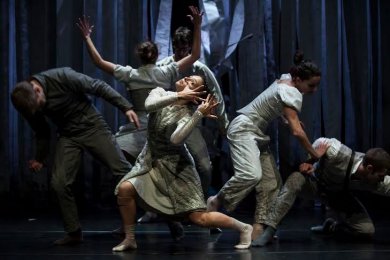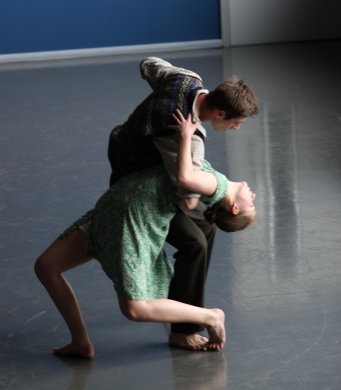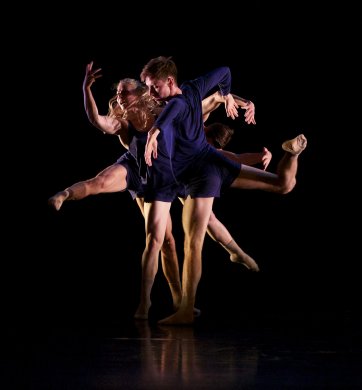
|   |

|   |
Scottish Dance Theater: Parameters of Nordic Black Humour, ultimate truth and hope - Sulagna Mukhopadhyay e-mail: sulagna64@gmail.com Photos courtesy: British Council November 9, 2014 As the curtain rises, the audience sees a grayish light engulfing the stage and a girl draped in grey costume and face painted white enters the stage from the middle with a dead bird in her hand. She has a mixed expression on her face - overwhelmed by her success in the hunt and confused about the harshness of the season WINTER. At this point begins the first song of Schubert’s Winterreise - Fremd bin ich eingezogen / Fremd zieh’ ich wieder aus. (I came here as an unknown / I am leaving this place again as a stranger.) So allegorical about the entire atmosphere prevailing on the stage! We remain in this world unknown to each other but fighting and quarrelling over earthly materials and natural elements. Using Andre Breton’s concept of surrealistic dark humour, Scottish Dance Theatre begins its first piece Winter Again at Kala Mandir on11th October 2014. Joe Stromgren projects Nordic Black Humour through his choreographic work. He caters to his audience the cycle of darkest, coldest season and the mysterious happenings of life during this time. There is a story line, albeit told in a fragmented narrative.  Winter again
Photo: Maria Falconer The girl is followed by two more dancers, who try to gather meat and other foodstuff for the harsh winter. Almost half of the 31-minute piece describes the trauma, the mental agony and the struggle to survive against Nature. Instead of the two side-wings, the dancers make a dramatic entrance and exit through paper-made blinds placed in the centre of the stage. There is a matter-of-fact voiceover at every interval trying to give a clue to the audience about the reality. One dancer enters the stage with an expression of triumph on his face as he is successful in snatching away the food of another passer-by. While a group throngs at one corner of the stage to discuss their hardships, one tries to rule over the other. Throughout the performance only one shade of light prevails - beige. A matter-of-fact voiceover tells the audience at times about what is happening on the stage. The dancers at times use sign language, a language as mentioned by the Artistic Director of the Company Fleur Darkin “emerged spontaneously while the work was on” is quite theatrical. Spring appears for a very short period giving joy to the morbid world but winter engulfs the jovial mood of the people in no time. The grimness begins slowly to look smug and Stromgen insists on discomfort. At the backdrop always one finds passers-by with their share of hunt on their shoulder. One man enters the stage and unable to snatch his share of food from another man, he runs to save his life. Though it is a marvelous, thought-provoking production by Stromgren, it is at times quite harsh for the audience to accept the sinister undertone. There is no shift of set, props used are birds, a small box, a bucket filled with blood. A girl blinded by some incident appears at the concluding part, her eyes bleeding profusely and the eye-sockets are missing (allegorical). She gropes through the stage like a zombie to find the bucket in which the eye-sockets are kept. She finds it finally and puts the sockets back to their position and colours her cheeks with the rest of the blood from the bucket. The entire group approaches the right front corner of the stage to watch with awe this girl and her courage to struggle through the winter. While Winter Again showcases Nordic Black Humour in a dance-theatre form, Revelator by Ruth Janssen through a blend of ballet and modern dance form deals with the frailties and the absurdities of human relationships through the seasons of life. The ultimate truth of life—death separates one person from the other. A short piece of 9 minutes, it reveals the routine fragmented life-style of a couple. The stage is completely dark and slowly it gets lighted with a young woman dancing around the stage, as if looking for someone. A young man enters the stage from the right wing and picks up the woman in his arms. Then he slowly puts her down and together approaches the centre-stage, both looking at the sky - a dream sequence. The couple circles each other alternatively to depict the conjugal life. They both look for individual space in their life. A slow piano number is the continuous background music. The boy suddenly picks up the girl on his left hand and both act as a see-saw - the balance between private and public life. The beautifully depicted part is the old age, where the girl stoops and walks across the stage, as if walking with a stick in hand, and the man follows her. With old age, man gets aches all over his body. Ruth in her piece does not leave her audience in any dilemma, rather deals gracefully with emotional nuances, which keeps a relation going. Though the performance is slow and at times creates boredom for the Indian audience, Janssen has worked at length to reveal the ultimate truth of life.  Revelator Photo: Nicole Guarino  In this storm Photo: Andy Ross The concluding piece of Scottish Dance Theatre In This Storm depicts hope. It was a sort of escape from darkness towards a ray of light. At the backdrop of a hand-painted cloth with streaks of two different shades of blue (just like the colour of the costume of the dancers), Henri Oguike gathers the dancers at the meeting point of different cultures. He brings music to life through his choreography. Beginning with the cacophony sound of violin (probably resembling a storm) the musical piece gradually elevates through sounds of chiming bells and thudding beats of drums to a height with Slovakian folk music as the concluding number. The musical pieces are exquisitely elegiac. Dressed identically in blue frills, the dancers go beyond gender norms. Both men and women are dressed alike. At the backdrop of a hand-painted cloth with streaks of two different shades of blue (just like the colour of the costume of the dancers), a male dancer makes his appearance on the stage (an embodiment of a single culture) and soon he is accompanied by another female dancer. They embrace each other through movements and later on with fast beats of music more dancers assemble at the meeting point. The beats are pretty fast except the beginning. The music is by Aleksandra Vrebalov. The movements are contemporary. Sulagna Mukhopadhyay was trained in Bharatanatyam by Guru Thankamani Kutty and Indian folk by Late Botu Pal. She has an M.A. in Comparative Literature and has freelanced for various leading newspapers of Kolkata like The Telegraph, The Statesman and Ananda Bazar Patrika. She has written articles on dance and gender issues. She is a teacher of South Point School since 1996. |